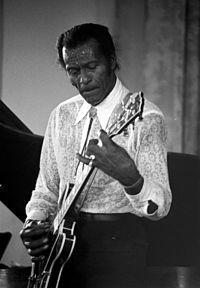Beat (music)
[clarification needed] In popular use, beat can refer to a variety of related concepts, including pulse, tempo, meter, specific rhythms, and groove.Rhythm in music is characterized by a repeating sequence of stressed and unstressed beats (often called "strong" and "weak") and divided into bars organized by time signature and tempo indications.Alternative expressions include "pickup" and "anacrusis" (the latter ultimately from Greek ana ["up towards"] and krousis ["strike"/"impact"] through French anacrouse).Subdivisions (like eighth notes) that fall between the pulse beats are even weaker and these, if used frequently in a rhythm, can also make it "off-beat".As a background against which to compare these various rhythms a bass drum strike on the downbeat and a constant eighth note subdivision on ride cymbal have been added, which would be counted as follows (bold denotes a stressed beat): So "off-beat" is a musical term, commonly applied to syncopation, that emphasizes the weak even beats of a bar, as opposed to the usual on-beat.[16] Other early recorded examples include the final verse of "Grand Slam" by Benny Goodman in 1942 and some sections of The Glenn Miller Orchestra's "(I've Got A Gal In) Kalamazoo", while amateur direct-to-disc recordings of Charlie Christian jamming at Minton's Playhouse around the same time have a sustained snare-drum backbeat on the hottest choruses.[19] In the mid-1940s "hillbilly" musicians the Delmore Brothers were turning out boogie tunes with a hard driving back beat, such as the No.[citation needed] Similarly Fred Maddox's characteristic backbeat, a slapping bass style, helped drive a rhythm that came to be known as rockabilly, one of the early forms of rock and roll.[18] Some songs, such as The Beatles' "Please Please Me" and "I Want to Hold Your Hand", The Knack's "Good Girls Don't" and Blondie's cover of The Nerves' "Hanging on the Telephone", employ a double backbeat pattern.


beat musicbeat (acoustics)drum beatbeat (disambiguation)music theorycountsrhythmsgroovetime signatureLeonard B. Meyermusic genresduple metertriple metertupletsquarter noteBach'sconductoranacrusispoetrysyllablesupstrokes44 timecountedaccentsyncopationAfrican polyrhythmBackbeat (disambiguation)Chuck BerryRock and Roll MusicsyncopatedGood Rockin' TonightWynonie HarrisEarl PalmerThe Fat ManFats DominoDixielandRoll 'Em PetePete JohnsonBig Joe TurnerHarry JamesBenny GoodmanGlenn Miller OrchestraCharlie ChristianMinton's PlayhouseLuiz GonzagahillbillyDelmore BrothersFred Maddoxslapping bassrockabillyrock and rollsnare drumfunk musicThe BeatlesPlease Please MeI Want to Hold Your HandThe KnackGood Girls Don'tBlondieThe NervesHanging on the TelephoneCross-beathypermetersensorimotorsynchronizationmotor responsepercussionreggaeone dropJames BrownMensural notationPapa's Got a Brand New BagFresh AirMaceo Parkerde Momigny, Jérôme-JosephRiemann, HugoCone, Edward T.RhythmAdditive and divisiveCanter rhythmColotomyCountingCount offDurationNote valueHalf-timeHarmonic rhythmHemiolaHomorhythmIsorhythmMetric modulationNon-retrogradable rhythmNotes inégalesPolyrhythmProlationProsodyRhythmic modeStop-timeTime pointTupletMusical notationAbbreviationDa capoDal segnoKey signatureLedger lineRehearsal letterRepeat signTranspositionTransposing instrumentMusical notesAccidentalnaturalCue noteDotted noteGrace noteNoteheadTremoloIntervalHelmholtz pitch notationLetter notationScientific pitch notationArticulationCaesuraDampingDynamics

